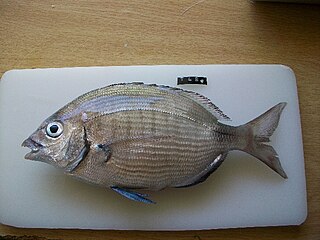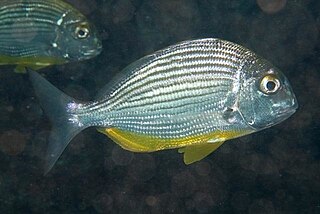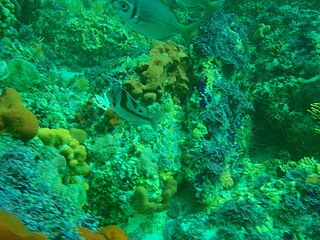
The panga, or panga seabream is a species of marine ray-finned fish belonging to the family Sparidae, which includes the seabreams and porgies. It is the only species in the monospecific genus Pterogymnus. This species is endemic to the coasts of South Africa. The panga is an important species in commercial line fisheries off South Africa.

Sparidae is a family of ray-finned fishes belonging to the order Spariformes, the seabreams and porgies, although they were traditionally classified in the order Perciformes. They are found in shallow temperate and tropical waters around the world and are demersal carnivores.

Chrysoblephus gibbiceps, the red stumpnose, red stumpnose seabream or Miss Lucy, is a species of marine ray-finned fish belonging to the family Sparidae, the seabreams and porgies. This fish is endemic to the southwestern Indian Ocean off the coast of South Africa. The International Union for Conservation of Nature classifies this species as Endangered.

Polysteganus is a genus of ray-finned fish belonging to the family Sparidae, which includes the seabreams and porgies. The fishes in this genus are found in the Indian Ocean.

Polyamblyodon gibbosum, the knife-back seabream or cristie, is a species of marine ray-finned fish belonging to the family Sparidae, which includes the seabreams and porgies. This species is endemic to the southwestern Indian Ocean.

Chrysoblephus puniceus, the slinger seabream, is a species of marine ray-finned fish belonging to the family Sparidae, the seabreams and porgies. This species is found in the southwestern Indian Ocean where it is endemic to Southern Africa.

Sparodon, commonly known as the white musselcracker, musselcracker seabream, mussel cracker seabream, brusher, or cracker. is a monotypic genus of fish in the family Sparidae. The type and only known species, Sparodon durbanensis, was first described and named by François Louis Nompar de Caumont de Laporte, comte de Castelnau, in 1861.

Diplodus hottentotus, the zebra, is a species of marine ray-finned fish belonging to the family Sparidae, which includes the seabreams and porgies. This fish is found in the Western Indian Ocean off Southern Africa.

Diplodus capensis, the Cape white seabream or blacktail seabream, is a species of marine ray-finned fish belonging to the family Sparidae, which includes the seabreams and porgies. This fish is found around the coasts of Southern Africa.

Rhabdosargus globiceps, the white stumpnose or go-home fish, is a species of marine ray-finned fish belonging to the family Sparidae, which includes the seabreams and porgies. This fish is endemic to the waters off Southern Africa.

Chrysoblephus anglicus, the Englishman seabream, is a species of marine ray-finned fish belonging to the family Sparidae, the seabreams and porgies. This fish is endemic to Southern Africa.

Rhabdosargus thorpei, the bigeye stumpnose, is a species of marine ray-finned fish belonging to the family Sparidae, which includes the seabreams and porgies. The bigeye stumpnose is endemic to the southwestern Indian Ocean.

Chrysoblephus is a genus of marine ray-finned fishes belonging to the family Sparidae, the sea breams and porgies. The fish in this genus are found in the western Indian Ocean and southeastern Atlantic Ocean.

Chrysoblephus cristiceps, the daggerhead seabream or dageraad, is a species of marine ray-finned fish belonging to the family Sparidae, the seabreams and porgies. This fish is endemic to the southwestern Indian Ocean and southeastern Atlantic Ocean off South Africa. This species is assessed as being Critically Endangered bt the International Union for Conservation of Nature.

Spondyliosoma emarginatum, the steentjie seabream, is a species of marine ray-finned fish belonging to the family Sparidae, which includes the seabreams and porgies. This species is found in the southeastern Atlantic Ocean and the southwestern Indian Ocean off South Africa and maybe Madagascar.
Chrysoblephus lophus, the false red stumpnose or the false Englishman, is a species of marine ray-finned fish belonging to the family Sparidae, the seabreams and porgies. This species is endemic to the South African waters of the southwestern Indian Ocean.
Argyrops filamentosus, the soldierbream, is a species of marine ray-finned fish belonging to the family Sparidae, the seabreams and porgies. This fish is found in the Western Indian Ocean.

Pachymetopon is a genus of marine ray-finned fishes belonging to the family Sparidae, which includes the seabreams and porgies. The species in this genus are endemic to Southern Africa.

Polyamblyodon germanum, the German seabream, is a species of marine ray-finned fish in the family Sparidae, which includes the seabreams and porgies. This species is found in the southwestern Indian Ocean.

The Dane seabream, also known as the Dane, is a species of marine ray-finned fish belonging to the family Sparidae, which includes the seabreams and porgies. The Dane seabream is the only species in the monospecific genus Porcostoma. This species is endemic to the southwestern Indian Ocean off the coast of Southern Africa.


















